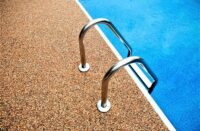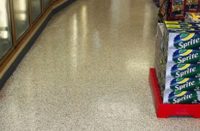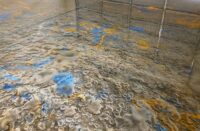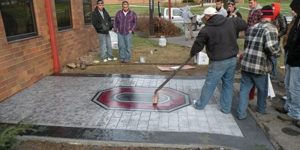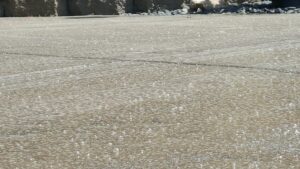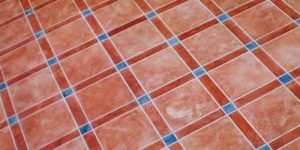Question
I have sealed concrete walkways and stairs that are about three months old. They are very slippery when wet or snowy. What can I do as a temporary fix in winter to minimize sealer slipperiness on concrete? I understand I can add an additive to a sealant and reseal. But that solution will have to wait until summer.
Answer
Using grit additives has become the most common method for reducing slipperiness when sealing decorative concrete flatwork on exterior walking surfaces. Mix the grit additives into the sealer, then apply the gritty sealer to the concrete. However, as the question states, in this situation the weather was too cold to reseal the concrete. So you should have another method in place until springtime arrives and temperatures rise consistently above 50 F.
The best temporary measure for dealing with slippery sealed surfaces is to broadcast sand over the affected areas. Also, using concrete-friendly snowmelt chemicals in conjunction with the sand helps eliminate snow or ice that can make a slippery surface even more dangerous. Almost any sand that is available at big-box or hardware stores will work.
While the use of grit additives mixed into sealers is fairly common, I find that most installers are not aware of what these powders are. Additionally, they are unaware of how they work, their proper use, or the fact that different types are available. For those who have read my columns and articles, you know I am a huge proponent of understanding the products and process. This is all about gaining a better understanding of the products you use on your projects and how to properly apply them.
Grit options
When it comes to grit additives for decorative concrete sealers, you can choose from a few different types. They all work the same way, by creating a rougher profile on the surface of the sealer. This creates more traction, reducing the slipperiness of the sealed surface.
The old-school grit additives are silica sands. These naturally mined sands come in various particle sizes ranging from 4 to 270 mesh. (The mesh number designates the number of openings on a square inch of a sieve. The larger the mesh number, the finer the particle size.) Either mix them into the sealer or broadcast on top of a sealer after applying. Sands used as grit additives in clear coatings usually have mesh numbers of 90 and greater.
The limitations for using silica sands as grit additives in sealers include their colors, which range from almost white to dark tan. Silica sands change the texture and aesthetics of the sealer surface. Most importantly, though, crystalline silica dust has been found to be a carcinogen.
The biggest of these limitations affecting the decorative concrete industry is how silica sand affects surface texture and aesthetics. Since decorative concrete is all about the visual appeal of the concrete surface, changing that with a silica grit additive can have a negative impact on the finished work. Many still use silica on often-colored higher-solids high-performance coatings, or on primer coats that require substantial surface texture. However, it’s not commonly used on one-part clear acrylic sealers or cure-and-seals.
Out of sight
In recent years, many have pushed toward using recycled material as grit additives. These include crumb rubber or mineral-based aggregates. But like silica sand, these are usually found in thicker high-performance coatings and primers. They are not common in clear thin-build sealers commonly used in decorative concrete applications.
Since final aesthetics are critical with decorative concrete projects, grit additives need to be invisible, if you will. The most common grit additives used in clear decorative concrete sealers today are just that — to a point.
Micronized polypropylene make up the majority of grit additives used in clear decorative concrete sealers. Sold under numerous trade names, micronized polypropylene is really not much more than ground-up plastic. It’s the same plastic as pails that hold color hardener, acid stain and many other industrial and consumer products. Its unique texture and uniform particle size make it special. This size and shape gives a smoother feel to the coating surface while decreasing the slipperiness, especially when wet.
Silica sand is angulated, which disturbs the visual aesthetics of the sealer. In contrast, the uniform particle shape and size of propylene powders do not have a major impact on surface aesthetics. In most cases you cannot see a difference in the coating, only feel a difference.
It is interesting to note that polypropylene grit additives have been used as texturing agents in paint and industrial coatings long before they found their way into clear sealers in our industry.
Mix it in properly
Most common brands of propylene grit on the market will work in solvent or water-based sealer or coating systems. They have a low density, which allows them to float throughout the sealer and not sink to the bottom like silica sand or heavier grits.
When adding them to a sealer, proper mixing is important. The standard mixing ratio is between 5 percent and 15 percent by sealer solids to obtain a medium level of grit. So, for example, a 25-percent solids acrylic sealer will call for 3.2 ounces of grit (10 percent load) per 1 gallon to achieve a medium level of texture. Most manufacturers pre-weigh the powder and designate it for a certain amount of sealer.
A common mistake is to use too much grit, thinking this will increase the level of slip protection. It will help to a point, but it can compromise the sealer durability very quickly. This can result in the sealer itself becoming cloudy.
When mixing polypropylene grit additives into sealers, I always recommend using a mechanical mixer (drill). Make sure it is a quality mixing blade designed for blending powders into liquids. Mix the powder into the sealer slowly and while the mixer is running. Avoid overdosing or adding the powder too fast, as this can lead to clumps and a cloudy sealer.
Lastly, if you do need a higher level of grit because the sealer is in a consistently wet or slip-prone area (kitchens, entryways, or around hot tubs and pools) consider using a larger particle size. Some manufacturers offer different-size polypropylene grits.
In today’s litigious society, slip-and-fall injuries are a major source of lawsuits. Safety always needs to be the number one factor with any project. As an installer using a clear coating, that can increase the potential for slips. It is your responsibility to work with your clients to educate them on the type of grit additives available and where and when you should use them.
Questions from Readers
Question
Using sand in a sealer for concrete does NOT work. The sand stays on top of the surface. Plus, when you add it to the sealant, it sinks to the bottom regardless how much you stir it. So, in other words, it isn’t a viable option.
Answer from Concrete Decor
Just to clarify, don’t add sand to a sealer when it’s still in the sprayer. Broadcast sand onto a sealed surface that’s still wet. It’s also important to use recommended mesh sizes and, equally important, clean and dry sand. Fine dusts in the sand will just lead to a bad-looking seal job.
Also, mixing aluminum oxide at 1.5 to 2 ounces per gallon will spray easily. In the time it takes to empty a container onto your concrete surface, it won’t settle to the bottom of the sprayer. Just make sure you mix it thoroughly.
Question
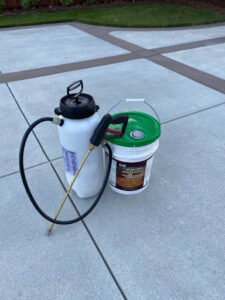 If I use penetrating sealer on my concrete driveway, will it still be slippery when wet?
If I use penetrating sealer on my concrete driveway, will it still be slippery when wet?
Answer from Concrete Decor’s publisher, Bent Mikkelsen
No. Penetrating sealers aren’t film forming, so they won’t create a slippery surface. I have a penetrating sealer on my driveway and like it a lot. I used Decra-Seal Natural, and it delivers the results I am after every time. As you can see, I use a Chapin Sprayer for initial application and then use a 1/2″ roller to move the product around. It helps to pick up any puddling of the product while also working it into the surface. Just make sure to apply your sealer in the cool of the day when the sun isn’t beating down on the surface.
